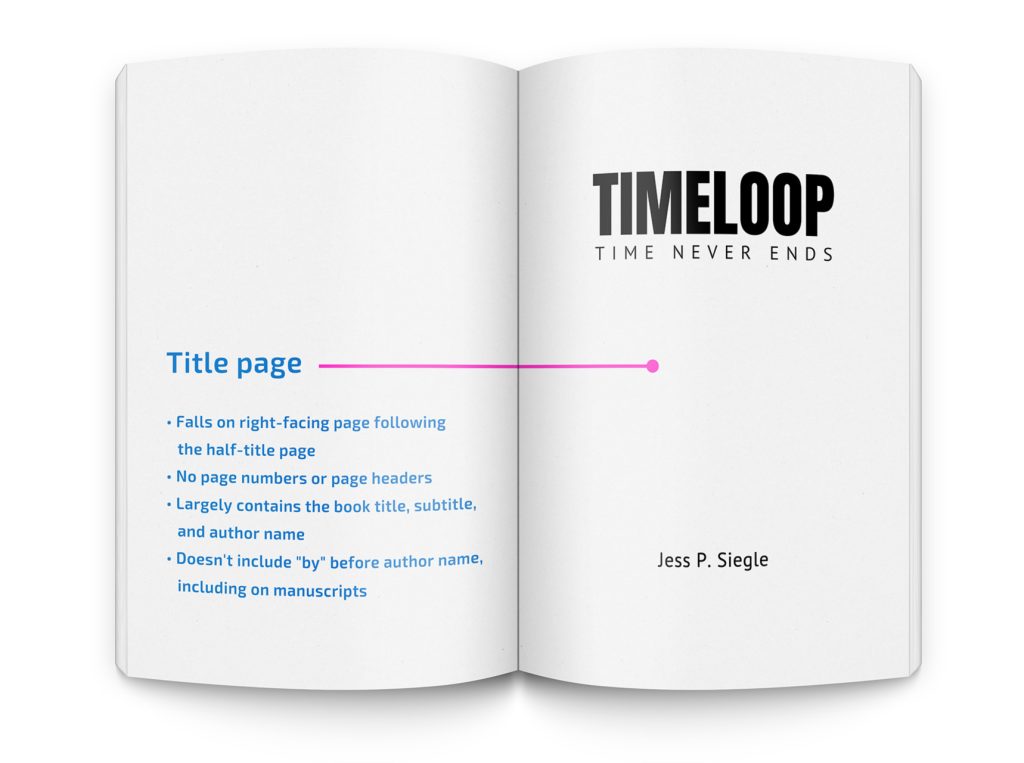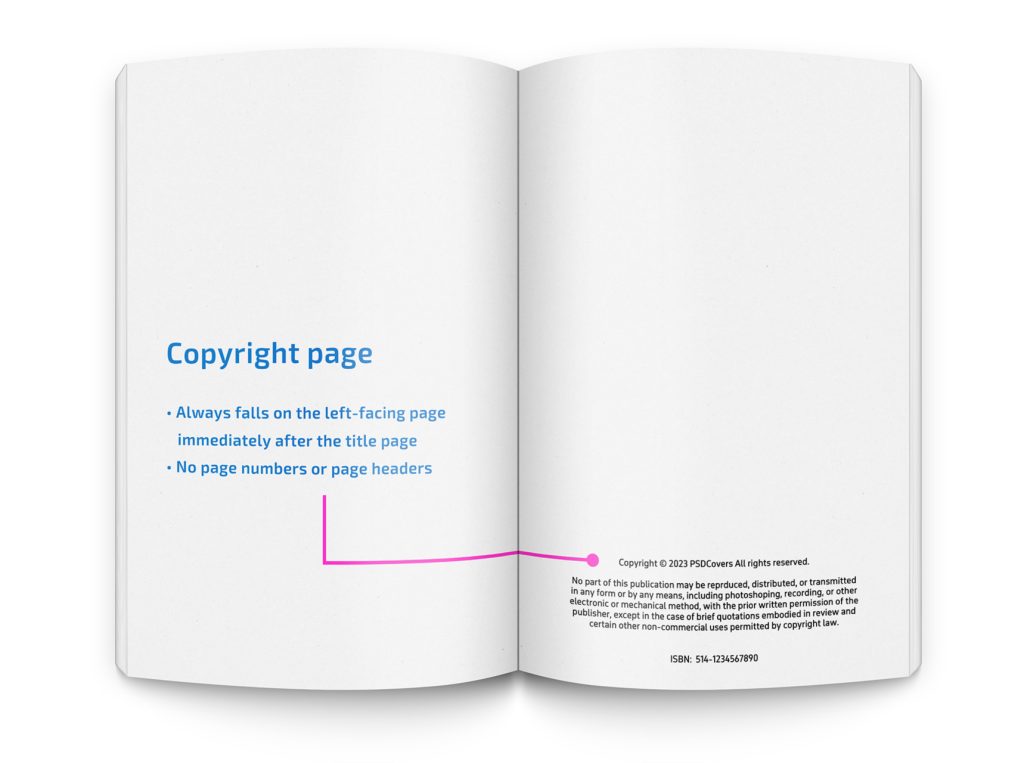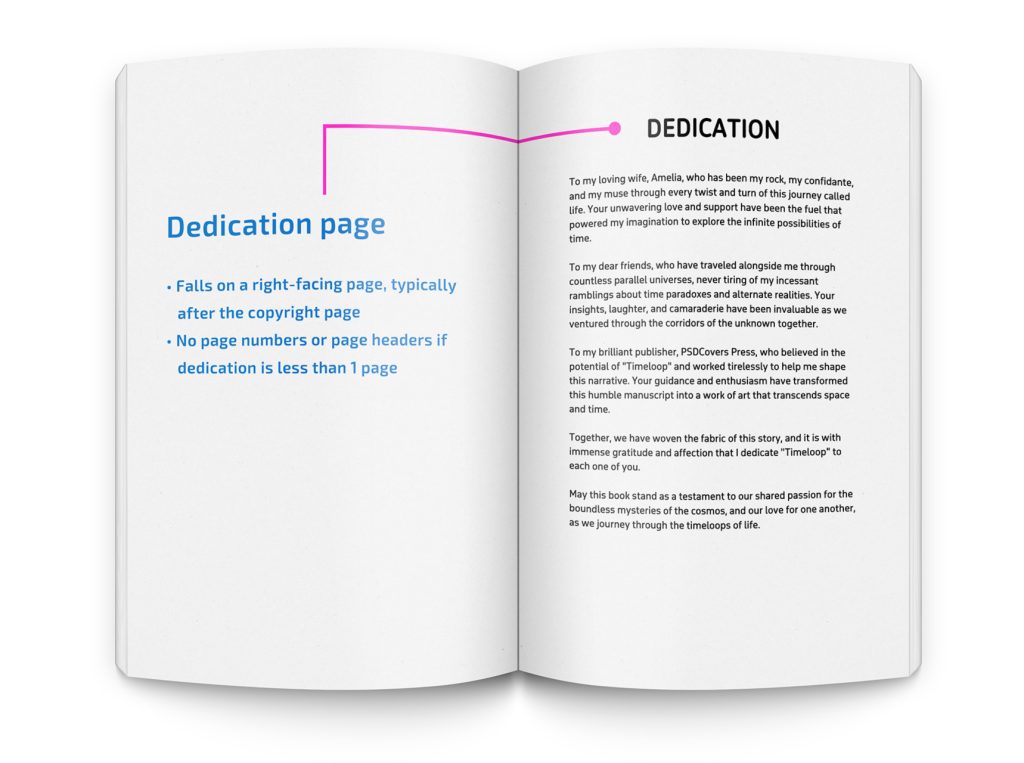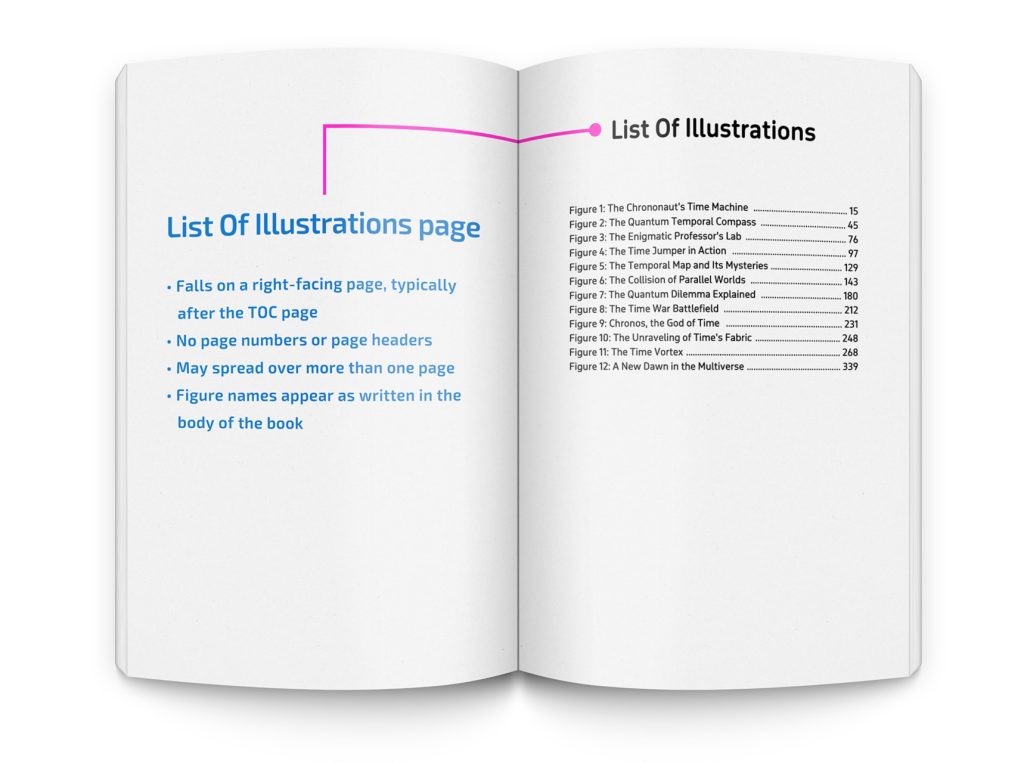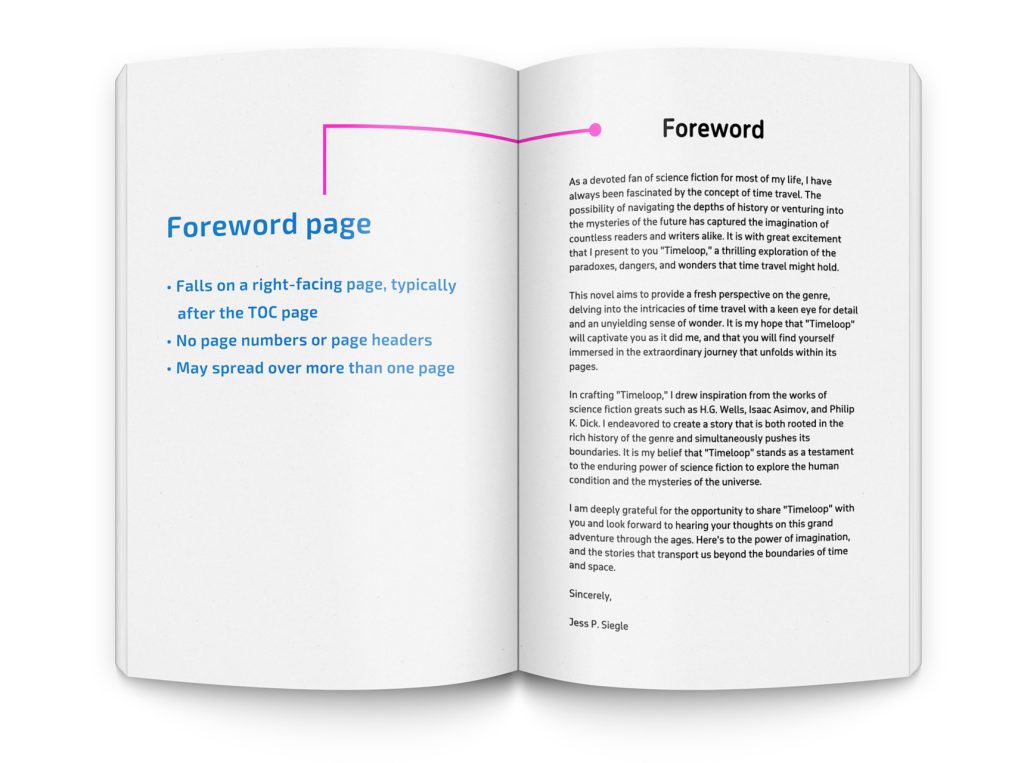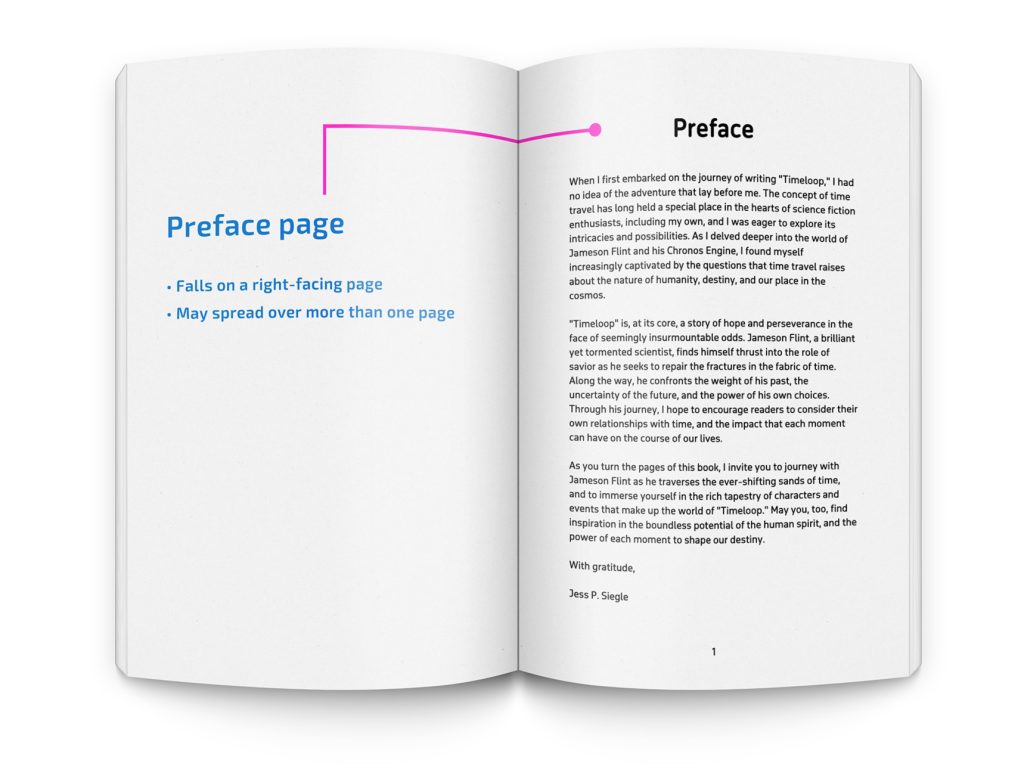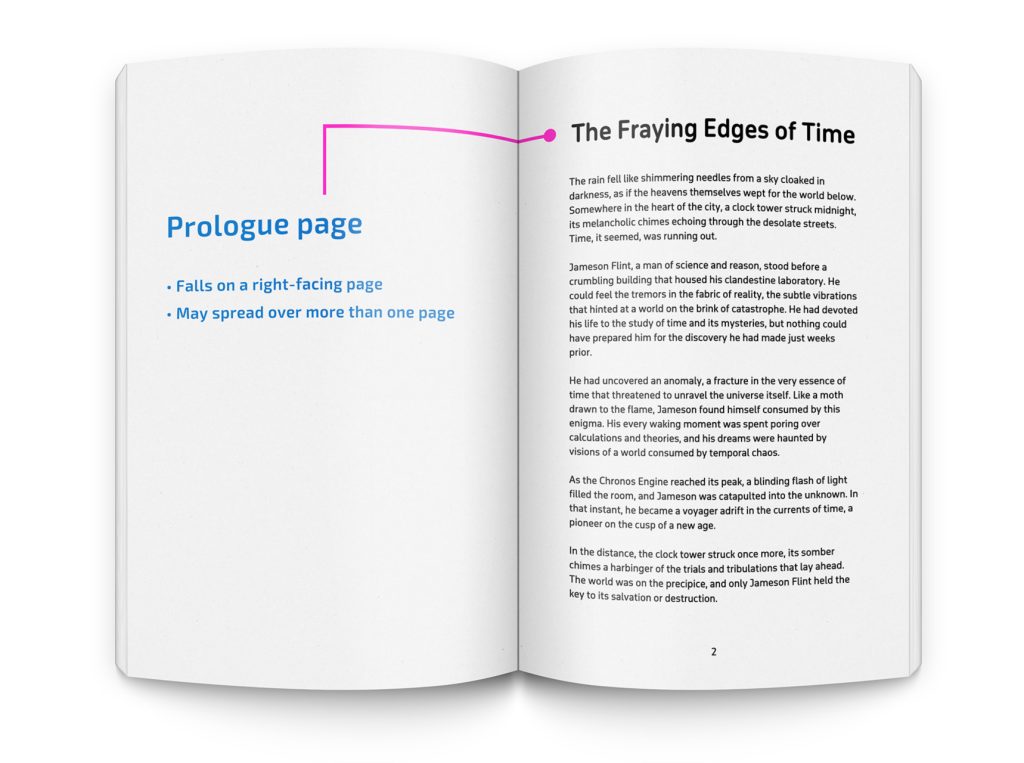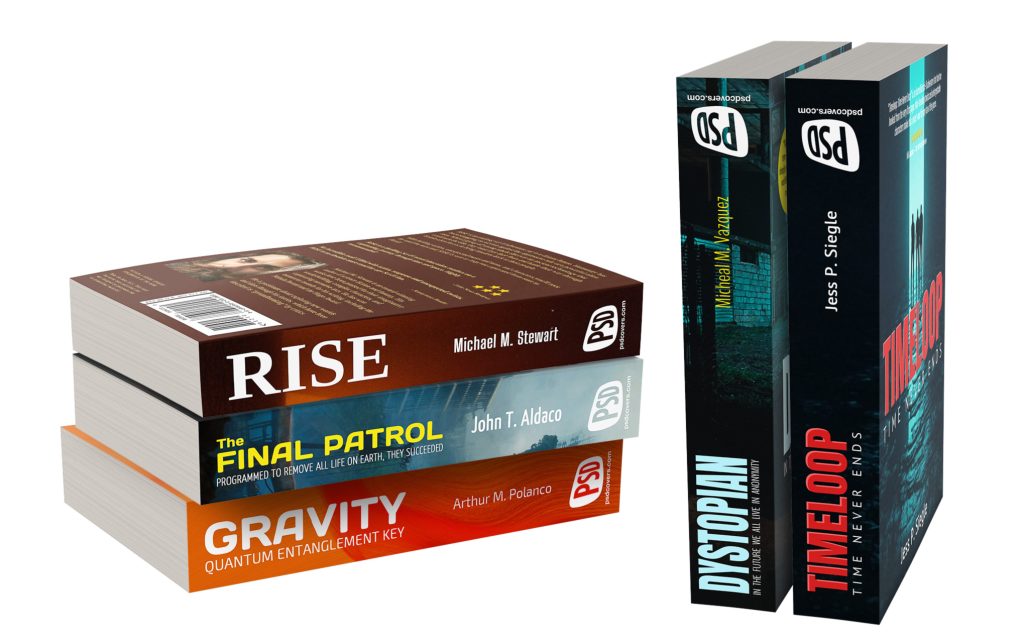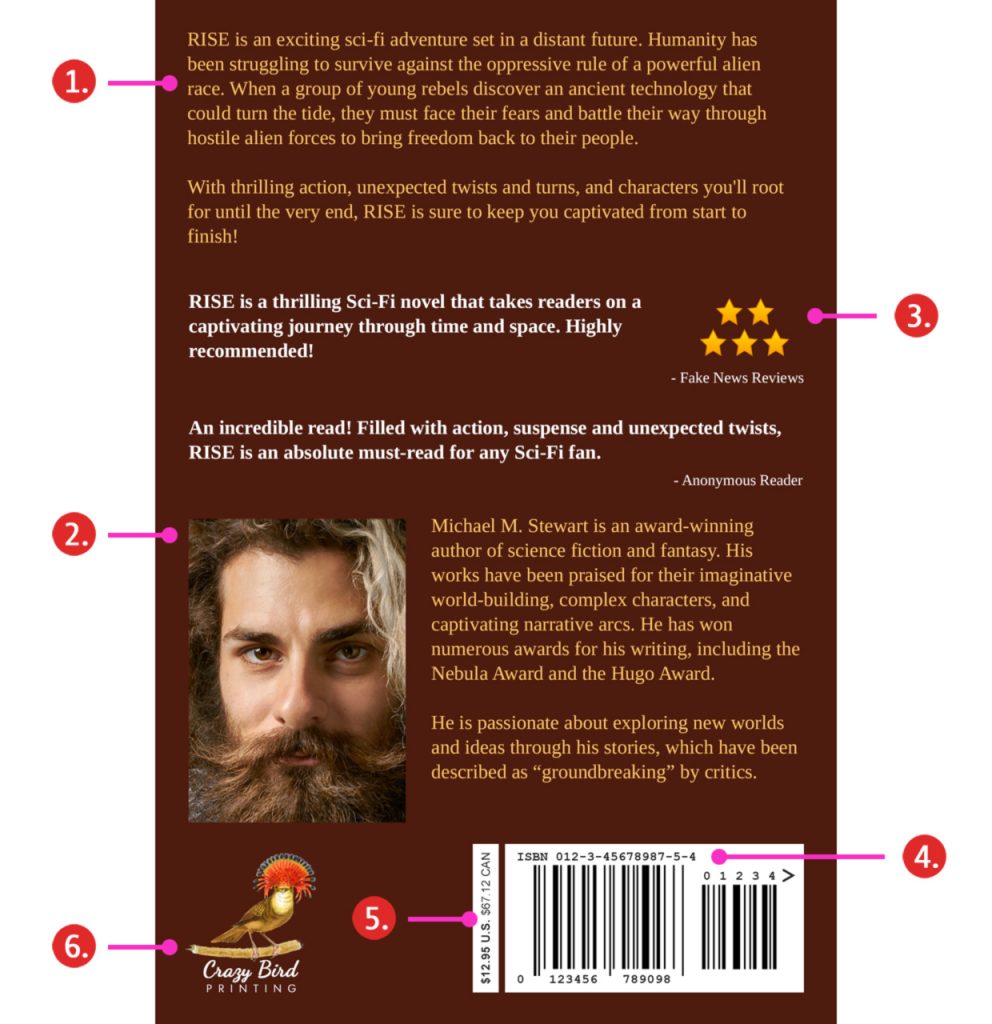How To Identify Parts Of A Book Cover Including Matter

A book cover design has two main components, typography and visuals. The typography helps to create an engaging title and subtitle for the reader. Meanwhile, the visual design often conveys a preview of the story’s genre, plot, or protagonist on the book cover.
[KiwiClickToTweet tweet=”Learn about the parts of a book and download some inspirational cover designs and free mockups to get started.” quote=”Learn about the parts of a book and download some inspirational cover designs and free mockups to get started.”]The book cover design wraps around the front matter, body matter and back matter of your book. Externally, the cover design represents the front, spine and back of the book.
The pages of a publication can be identified as having three main components, the front matter, body matter and back matter.
The front matter is the first several pages where the reader can find things such as the title page, foreword and preface.
The body matter is the core of your book, it largely contains chapters and pagination. Lastly there is the back matter which is located in the final dozen or more pages of the book. This is where the epilogue, glossary, appendix and author biography can be found.
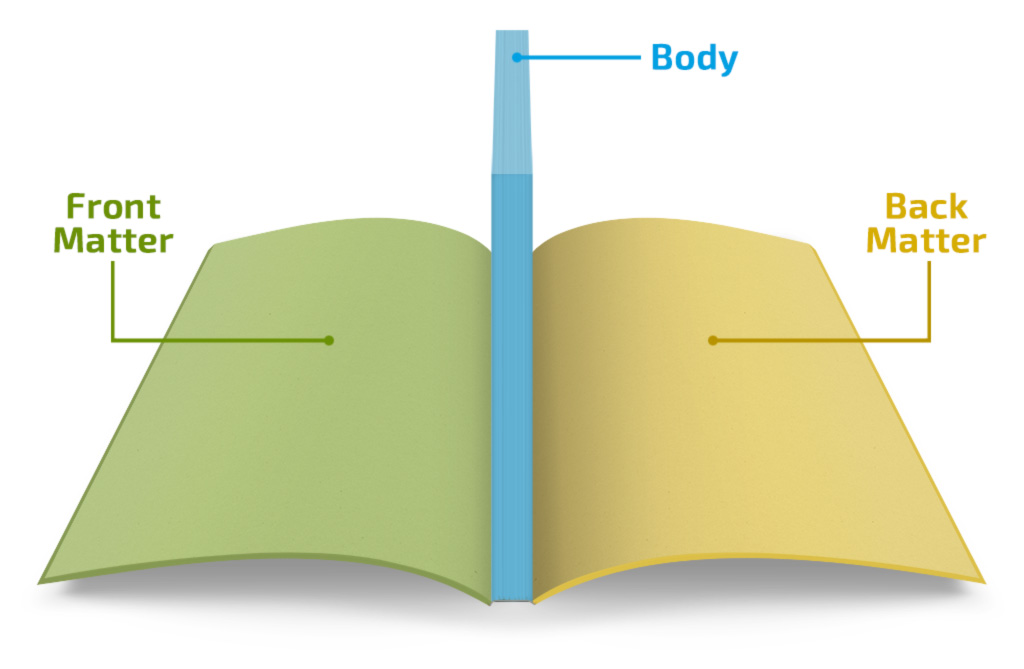
Book with callouts identifying the front matter, body and back matter.
What Are The Basic Parts Of A Book Cover?
The constituent parts of a book cover include the front, spine and back layouts. A book cover layout can stretch across the front, spine and back of the book. Each of these parts contain specific design elements. For example, design elements on the front of the book may include the title, sub-title, imagery and author’s name.
These design elements can also help to highlight the genre of the publication, protagonist and even the plot. The spine and back of the book cover can similarly be broken into smaller elements.

The Kardashev Lost Sc-Fi Book Cover template is a free PSD download.
What Should The Constituent Parts Of A Book Cover Include?
Here are the 6 elements which constitute the overall parts of a book cover:
- Book Cover: Title, subtitle, background imagery and author’s name.
- Front Matter: Table of contents, copyright notice and preface or dedication.
- Body: Core of the work which includes pagination and chapters.
- Back Matter: Epilogue, appendix and author’s biography.
- Spine: Features your title, author’s name and publishing company logo.
- Back Cover: Description of the story, reviews, ISBN number and barcode.
What Should Your Book Cover Include?
Your book cover can serve as an attention-grabber and give the public a preview of what it’s about. A well-designed cover has the potential to draw patrons into your website, Amazon or Facebook marketplace. This makes your designs essential for successful marketing and why you should try to work with good designers.

Example of an attention-grabbing Sci-fi front cover design.
Why are book cover designs important for the audience?
Your book covers are important because it must visually appeal to your audience in 2 minutes or less to encourage sales. This is how the public can make an informed decision on whether they want to invest their time reading it.
The imagery and typography should also work together to convey the genre and theme of the story.

Your book cover designs are a powerful tool in attracting the public to read your book.
Your book cover should include these design elements:
Relevant Cover Imagery
The book cover is the most crucial element to promote your work — it’s the first thing purchasers will notice. the cover creates the first impression and serves as a lasting memory for your patrons. To draw in potential purchasers, use imagery on the cover which best represents elements within the body matter.
It’s always a good idea to research material in the same genre and use those book cover designs as a guideline on what your designer should avoid. This is because you want your own book covers to be original and stand apart from the other covers. Using a similar layout, color palette or imagery to other material currently in circulation might confuse your potential patrons.
The designs should also reflect the genre or theme of the storyline. Being honest with the imagery makes your book cover more receptive to your patrons.
Captivating Title Using Stand Out Typography
While designing the cover mockup it’s essential to keep in mind that the title should be crystal clear and straightforward. This is especially true for non-fiction titles.
Selecting the right typeface plays an important role in setting the mood for your visual content. If you want to evoke romance, opt for more fluid fonts. For a funny mood, choose whimsical fonts and use bold and strong typefaces to create a sense of drama or adventure.

Background imagery, Title, Sub-title and Author name included in book cover layout.
Spoiler-Free Subtitle Hinting Towards A Plot
Have a subtitle which offers revealing hints about the plot without offering spoilers. The subtitle is a major component for any patron looking for a glimpse of what your story is about. Your subtitle helps them make an informed decision on whether they want to invest their time reading your publication.
Author’s Name
The author’s name is almost always added to the book cover. Some patrons make their purchasing decisions based on the name of the author alone.
Check Out Our Cover Book Design Template Collection
If you don’t have access to a designer or cover book design resources you can browse our free book template collection. Our templates are made using Adobe Photoshop and include fonts from Google and photos from Unsplash. All templates are clearly listed within each post as well as in the downloadable PSD.
Using our mockup generator for Adobe Photoshop, you can create a cover and save your PSD template.
What Should Your Book Front Matter Include?
The front matter of a book includes several sections that come before the main content of the book (ie, the body matter).
Why is the front matter of the book important?
By providing information in the front matter, you can enhance the reading experience. This will make it even more enjoyable for the public paying money and becoming a long term patron of your work.
The sections within the front matter may include the following:
Half title page
On the first page of any publication, you’ll usually find the title, sometimes referred to as the “flytitle” or “bastard title”. The half title page helps the public know what they are reading before they start reading it. The original purpose for including a half title page was to protect the title page from wear and tear. The author’s name is generally not included on this page.
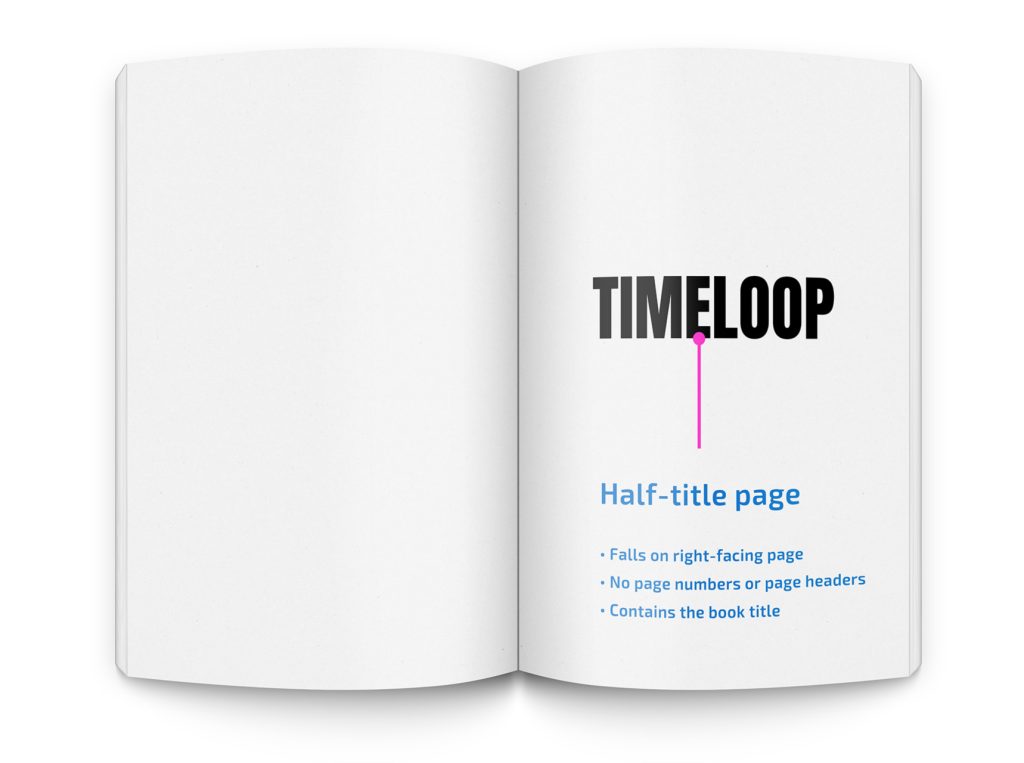
Half-title page always appears on the right facing page of a two page spread layout.
Title page
Lacking any half title page, the next section you’ll encounter is the title page. This page displays the title of your work, the author’s name and a descriptive picture or design if desired. The title page helps the public know what the work is about before they start reading.
Copyright page
A Copyright page lets you know who owns the rights to the text. The publishing date, copyright holder and where it was printed can be found on this page. This page also includes the International Standard Book Number (ISBN), and edition number. Whenever you create original content like a publication or artwork, it belongs to you. The Copyright page lets the public know your work is protected and may not be copied without permission.
Dedication page
The dedication page is where the author thanks those who helped them write the text. Those mentioned could be their friends, family members or even teachers. In fact, anyone who may have supported the author can be included. The dedication page usually appears at the beginning, just after the title page.
Epigraph
An epigraph is similar to a quote which is placed within the first few pages. The epigraph offers a hint about the publication’s storyline written by the author or possibly another well known author. It’s like an extra special introduction to the story that helps set the mood for reading it.
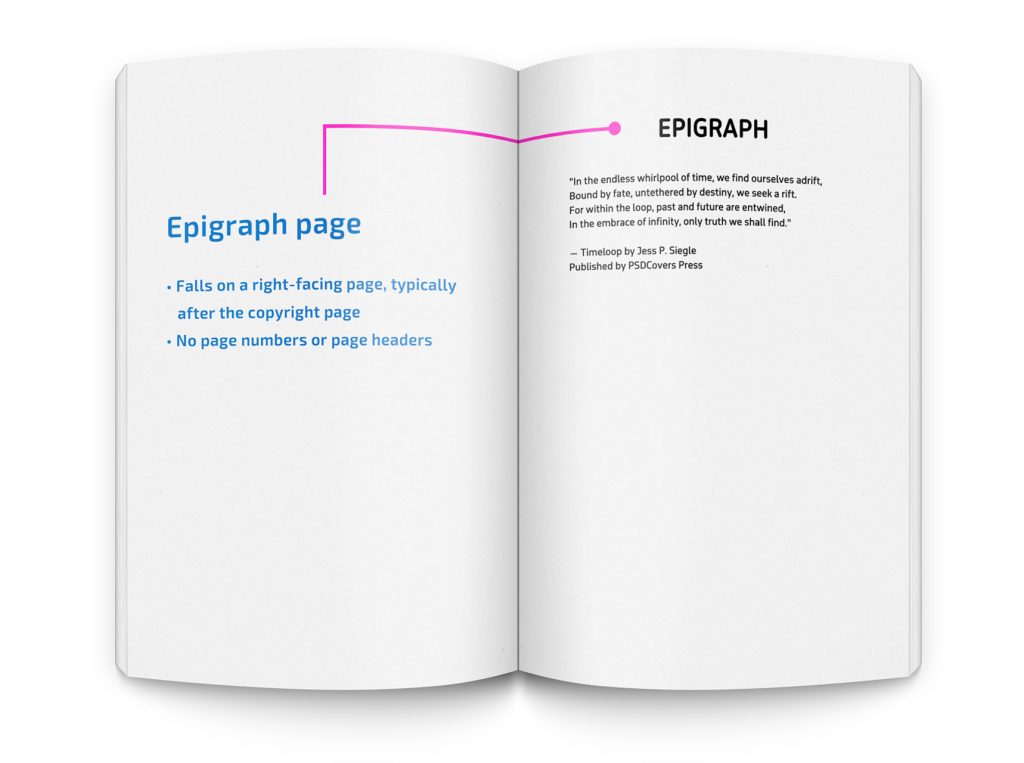
Epigraph page is less commonly added page but when it is added appears on the right facing page following the dedication page.
Table of contents
A table of contents is like a map for the material. It outlines what the material is about and provides an overview of its different parts. Listed within the table of contents are the names of each chapter, special sections or appendix. When skimming through the table the public can get an idea of the pace of your writing. This helps your viewers locate information quickly and easily.
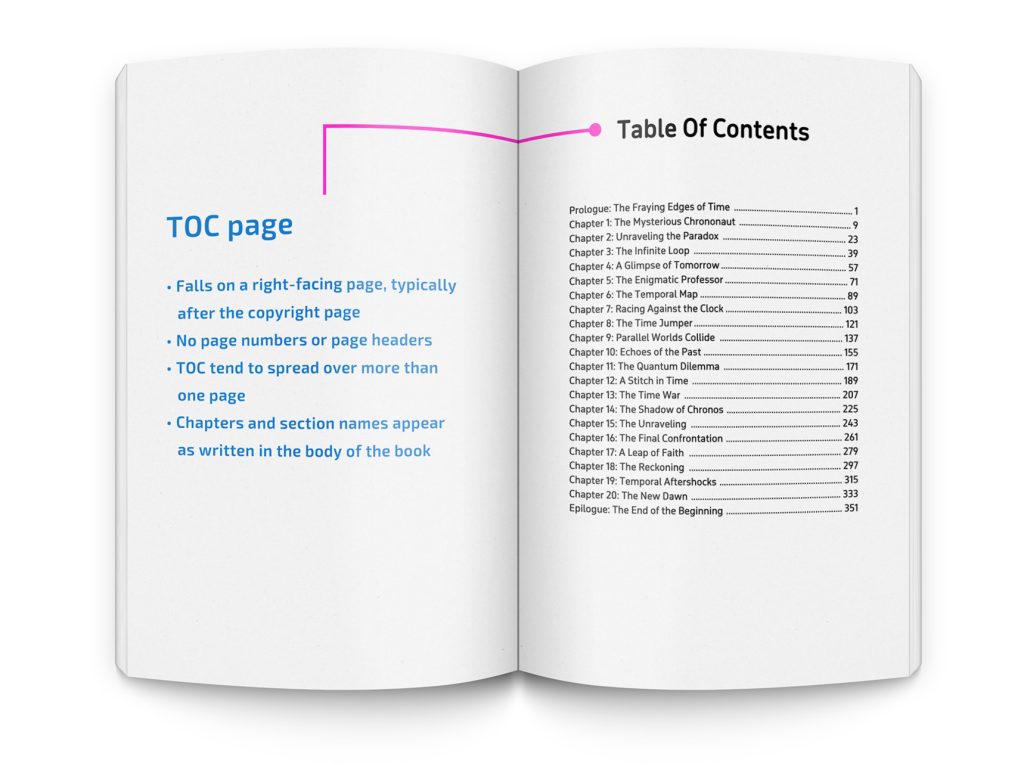
Table Of Contents (TOC) page is appears on the right facing page following the dedication or epigraph page.
List of illustrations
Publications which offer illustrations will often provide a helpful list with descriptions and which pages to view them on. Pictures and diagrams are helpful in allowing the public visualize what is being described in the body matter.
Foreword
Most publications offer a foreword at the beginning which introduces the material. It’s usually written by someone close to the author who shares why they think the text is important or special. Think of the foreword as a recommendation from a third-party that you really need to read this material.
Preface
A preface appears before the main story where the author can explain why they wrote the book. The preface allows the author to address the public, directly helping to answer questions and provide reasons why they should become a patron.
Prologue
An introduction to a book provides the public with an insight into what the work is about, who are the important characters & concepts featured within. It gives you a preview of what’s to come and helps create excitement and anticipation for continuing further with the story. Narratives, dialogues and authorial interjections are all popular methods of using language to tell a story. These can be included as part of the narrative, provide insight into characters’ conversations and allow the author to convey their point across in a clear manner.
What Does The Book Body Include?
The body consists of the informational text and its most recognizable elements.
Those elements are:
Chapters
Books are divided into chapters. Chapters help to divide a book into smaller sections which address a specific theme or topic. In the case of an Action or Romance book, chapters can act like an event timeline. Chapters help the viewer to better recall when and where in a story something happened. In the case of educational books, chapters serve as a way for the public to quickly target topics they are interested in.
Paragraphs
In writing, a paragraph is an important element found in both fiction and non-fiction pieces. It consists of several sentences that form a cohesive unit of thought. To distinguish the start of new paragraphs, indentation is used when writing essays, research papers, and books. Every new paragraph should have an indentation to make it noticeable.
Headings
The title of the publication itself can be viewed as a heading. When talking about headings within the body matter we are referring to the title of the chapter. The heading is used to present the public with a glimpse into what lies ahead in the chapter.
Subheadings
Subheadings, or sub-title, immediately follow the heading at the start of a chapter. Presented in a smaller size, subheadings provide extra information about a given topic that may not fit in the heading. You can locate subheadings in non-fiction books such as informational or instructional texts. They work to provide an extra layer of detail and clarity to written work.
Lists
Lists are a great way to organize information as bullet points. Lists are commonly found in non-fiction books where these can ensure clarity and conciseness.
Quotations
Non-fiction books often contain quotes from subject matter experts or a paraphrased version of the quote. The text surrounding the quote may serve as a deeper description of the quote. In other cases, the quote may be presented as validation for the text.
Footnotes and endnotes
Footnotes are extra, relevant details placed at the bottom of a page. Found in non-fiction books, footnotes are referenced in the main body with superscript numbers.
Tables and figures
Tables and figures used in non-fiction books often illustrate or present complex data. When many tables or figures appear in a non-fiction work it is common to include these as separated lists. These lists then allow the viewer to locate where they appear in the body matter.
Index
An index appears towards the back of the publication and lists the location of specific topics within the body matter. For example, the index found in an instructional text such as your vehicle’s user manual is very helpful to locate information. Instead of scanning every page for instances of the term “oil change” you’d simply use the index to quickly locate every page where the topic “oil change” appears in the book.
Writing a book requires skill, creativity and knowledge. Creating a balance between these is key for successful communication with your reader. It should be engaging enough to understand while maintaining their attention. These factors ensure a delightful and engaging reading experience.
What Should Your Book Back Matter Include?
At the end of the book, you will find several sections known as back matter.
These parts may include:
Appendices
Appendices are a great way to provide extra information to your book. They can contain supplementary data, diagrams, tables, and other materials that can enhance the main content without being essential for it.
Glossary
Glossaries can be invaluable additions to any book, providing access to alphabetically listed terms & their definitions. This makes it easier for those with little understanding of technical words or jargon to comprehend the material presented in the book.
Bibliography
Constructing a bibliography is another section of any book. The bibliography is a list of source materials that were consulted during research & writing of the book.
Acknowledgments
Acknowledgments are a way to show gratitude to those who helped you with your book. This may include editors, researchers, family members, and friends. Anyone who guided and assisted in the writing process may be included.
Afterword
An afterword is added to a publication once it’s finished. The author may write a summation of their writing journey, or provide an update on the content of the book. Sometimes this amounts to simple thoughts and ideas about the content itself.
Author’s note
An author’s note provides extra information about the body matter. This may include the source of inspiration or the amount of research undertaken. It can also reveal funding, disclaimers or conflicts of interest.
Epilogue
An epilogue is a necessary final chapter in any novel. It typically follows the main setting and storyline and provides closure, while also leaving some room for speculation on future plotlines. Epilogues are known for providing a glimpse into the future, often through a significant time jump that reveals the fate of the characters and address any remaining storylines. Epilogues offer insight into the events of upcoming installments, allowing the public to get a glimpse of what lies ahead in the next book.
Errata
An erratum (or errata, if referring to a list of errors in a published text) is an essential way to correct detailing mistakes before they are passed on to the public. It’s especially important in academic publications; any significant changes must be documented, as well as any alterations to authorship details if the original list was inaccurate. Errata generally don’t consist of minor typographical blunders, for example misspelled words or incorrect grammar that does not alter the meaning.
The inclusion of further sections and details in a publication is at the author’s discretion. New additions should depend on relevancy and what the author wants to communicate. Ultimately, the goal should be to create an experience that is engaging and satisfying.
What Should Your Book Covers Spine Include?
If you want to draw attention with your book covers spine design, go for a minimalist approach. The title on the book cover should be placed at the top in large font size, followed by the name of the author towards the bottom, and finally incorporating the publisher’s logo or imprint.
Adding imagery can, in some cases, significantly raise the chances of the public noticing it on the shelf next to other covers.
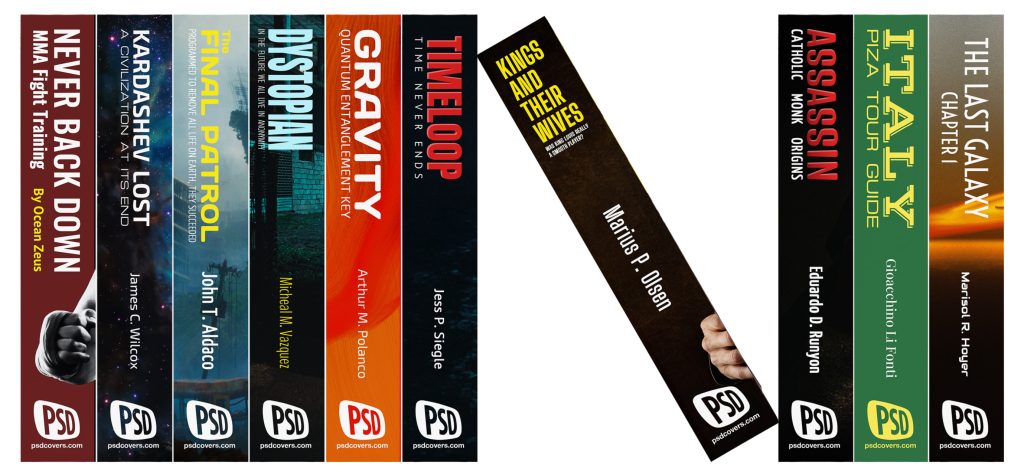
Top-to-bottom spine samples on an Octavo 6X9 book
Why is the book cover’s spine important?
If you are a self-published author your work will likely be placed vertically on the shelves. This is why a book cover’s spine is so important—when placed vertically with dozens of other publications your spine’s design must stand out from the other book covers. Due to how books are placed on shelves, people who are browsing the shelves will initially be prompted to grab your book based on their interest on the spine.
Which direction does the title on the spine go?
The direction of the title on the goes top-to-bottom (descending). Books printed in the United States and Common Wealth countries follow the industry standards as laid out in ANSI/NISO Z39.41 and ISO 6357.
In some cases the title on the goes right-to-left (traverse spine title). However, this is only recommended if the publication is deep enough to display the text legibly.
The right-to-left (traverse spine title) is also part of the ANSI/NISO Z39.41 standard under section 6.2 Title Orientation.
In Latin America, continental Europe and the Canadian province of Quebec the title goes bottom-to-top (ascending).
What Should Backside Book Cover Designs Include?
Backside book covers should include a glimpse into the contents and author of the work. These details help potential buyers decide whether they want to leave the store with a copy in hand.
A typical back cover will include some or all of these elements:
The book summary
A summary of a book is extremely important to gain a deeper understanding of the plot, characters and themes presented. It can be an invaluable aid in helping the readership form an opinion about the work. This concise review of the work should help them to gain a better understanding of its primary themes & topics, allowing them to appreciate it more thoroughly. Fundamentally, the summary is like a roadmap that leads the public through the story. It emphasizes the most significant aspects while also giving context to enhance the overall reading experience.
Author’s bio, photo
An author bio is a brief written summary that gives the public a glimpse into the background of the person who wrote the publication. Found on the backside of the book cover, the author bio provides details about the author, such as their education and notable achievements. The bio may also include details about the author’s interests that may be relevant to the work they have written.
Endorsements or reviews
Reviews and endorsements from trusted sources have been a great source of validation for the publication and its author. These collective quotes give a great impression to potential readers, making it much easier for them to choose the right book.
ISBN and barcode
Publications generally have two identification numbers. The ISBN (International Standard Book Number), which is a unique number indicating the publication title and edition. This is followed by the barcode, which is a scan-able pattern used to track the publication’s inventory status.
Price
The price of the publication usually appears on the back cover near the bar code. It can sometimes be printed as part of the overall cover or as a manually placed sticker tag.
Publisher’s logo
By having a distinct logo associated with the publisher, the public is able to quickly identify their preferred volumes and easily find titles from the same publisher. It makes it much simpler for them to locate more content they may be interested in.
Call to action
Using a call to action is a powerful technique to encourage the public to become more engaged with a book. Ideally it encourages them to become a patron, visit the website, or even leave a review.
Other books by the author
If you enjoyed a specific work by an author, wouldn’t you be their other literary works? A list of the author’s other books is a great way to discover more of the artist’s writing.
A well presented backside book cover is a great way to introduce the readership to your other books and works.
Conclusion
Investing the time to design an eye-catching book cover is a good investment. Even if you have minimal design experience, you can still come up with surprising outcomes. Your book cover is an invaluable marketing tool and should not be overlooked. Whether you choose traditional or digital publishing, having a well-designed cover is key to ensuring a successful journey.


